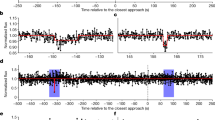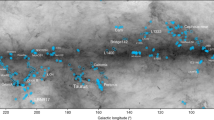Abstract
IT has been suggested1,2 that small satellites of diameter less than 50 km (moonlets) could exist within planetary rings, and could cause 'grooves' of low density in the adjacent ring material. Here we re-examine this hypothesis by comparing the numerical simulations of the gravitational influence of a moonlet on the radial density profile3–5with the occupation data collected by the Voyager ultraviolet spectrometer (UVS). We inspected by eye the UVS optical-depth profile of Saturn's rings to identify features similar to those predicted theoretically, and those examples found were analysed statistically to exclude the possibility of a chance origin. Six significant features in the radial optical-depth profile have been found, which could be caused by moonlets ranging in size between 7 km and 30 km, located mainly in the middle of the B-ring.
This is a preview of subscription content, access via your institution
Access options
Subscribe to this journal
Receive 51 print issues and online access
$199.00 per year
only $3.90 per issue
Buy this article
- Purchase on Springer Link
- Instant access to full article PDF
Prices may be subject to local taxes which are calculated during checkout
Similar content being viewed by others
References
Lissauer, J. J., Shu, F. H. & Cuzzi, J. N. Nature 292, 707–711 (1981).
Hénon, M. Nature 293, 33–35 (1981).
Spahn, F. Icarus 71, 69–77 (1987).
Spahn, F. Earth, Moon and Planets 39, 243–249 (1987).
Spahn, F. & Wiebicke, H.-J. Icarus 77, 124–134 (1989).
Weidenschilling, S. J., Chapman, C. R., Davis, D. R. & Greenberg, R. in Planetary Rings (eds Greenberg, R. & Brahic, A.) 367–415 (University of Arizona Press, Tucson, 1984).
Cuzzi, J. N. & Scargle, J. D. Astrophys. J. 292, 276–290 (1985).
Showalter, M. R., Cuzzi, J. N., Marouf, E. A. & Esposito, L. W. Icarus 66, 297–323 (1986).
Shu, F. H. in Planetary Rings (eds Greenberg, R. & Brahic, A.) 513–561 (University of Arizona Press, Tucson, 1984).
Goldreich, P. & Tremaine, S. Icarus 34, 227–239 (1978).
Bridges, F. G., Hatzes, A. & Lin, D. N. C. Nature 309, 333–335 (1984).
Lissauer, J. J. & Cuzzi, J. N. Astr. J. 87, 1051–1058 (1982).
Cuzzi, J. N. et al. in Planetary Rings (eds Greenberg, R. & Brahic, A.) 73–199 (University of Arizona Press, Tucson, 1984).
Author information
Authors and Affiliations
Rights and permissions
About this article
Cite this article
Spahn, F., Sponholz, H. Existence of moonlets in Saturn's rings inferred from the optical depth profile. Nature 339, 607–608 (1989). https://doi.org/10.1038/339607a0
Received:
Accepted:
Issue Date:
DOI: https://doi.org/10.1038/339607a0
This article is cited by
-
A belt of moonlets in Saturn’s A ring
Nature (2007)
-
Orbits of shepherd satellites deduced from the structure of the rings of Uranus
Nature (1990)
Comments
By submitting a comment you agree to abide by our Terms and Community Guidelines. If you find something abusive or that does not comply with our terms or guidelines please flag it as inappropriate.



